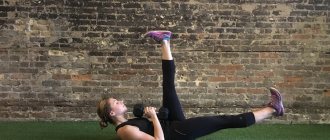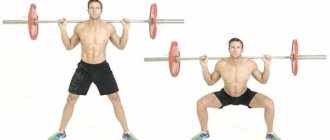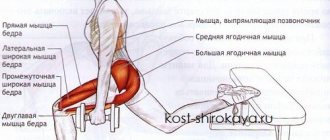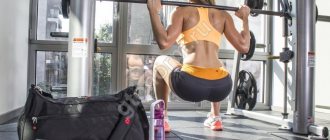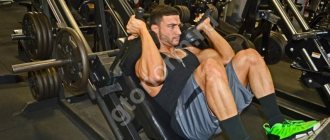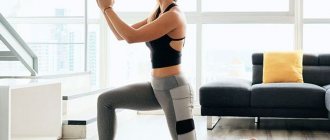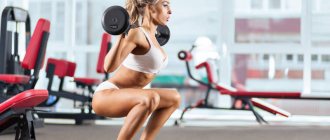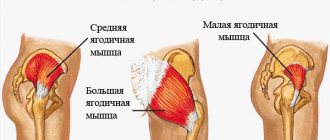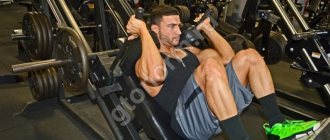What muscles are used by the hack squat?
This is a large muscle group located on the front of the thigh. Consists of 4 heads:
- Lateral. External head. Its development will help make the hips more massive.
- Medial. The inner head is located above the knee.
- Intermediate. This is the inner head.
At the top they are attached to the femur. And below, passing into the common tendon to the tibial tuberosity. That is, when the legs are bent, they stretch as much as possible. And then, due to their contraction, the knee joint is extended. As for the fourth head, then everything is not so simple.
- Straight (long) head. Unlike the previous ones, it is attached at the top to the pelvic bones. Consequently, its slope greatly affects its length. IN SQUATS WITH A BAR ON THE SHOULDER, at the bottom point, we lean forward a little. This allows this head to be stretched. Therefore, we can sit down as deeply as possible without experiencing discomfort. In the hack machine, our back is fixed, so we won’t be able to bend forward. Because of this, the front head cannot stretch to its full length. Therefore, at the lowest point, it acts as a resistance that will pull the femur towards itself. This will prevent people with poor stretching from sitting below parallel to the floor. In this case, there may be pain in the knee joint.
You can learn more about the leg muscles from the article “ANATOMY OF THE LEG MUSCLES“
The exercise also involves the muscles of the posterior thigh. These include:
- Biceps. It consists of two heads. A short one that attaches to the femur and helps perform the movement. And it is long, just like the rectus muscle, it crosses two joints, the femoral and knee. Therefore, at the lowest point it practically does not elongate. Consequently, it does not participate in movement, and the load on it is minimal.
- Semitendinosus and semimembranosus . They have similar attachment points. And in this exercise, they perform a stabilizing function of the hip.
And of course, in any squats, the tension falls on the lower leg muscles. Namely:
- Gastrocnemius and soleus. They stabilize the lower leg in this exercise.
Also taking part in the exercise are:
- Gluteal muscles
But due to the vertical position of the body, the load on them is very small. Since these muscles are at the lowest point, they cannot stretch to their full length. Therefore, hack squats will not be able to greatly influence their development.
In some variations of the exercise, the adductor muscles work.
From all of the above, we can draw a conclusion. That hack squats in a machine are not entirely anatomically convenient for us. Therefore, athletes with poor leg stretching will find it difficult to squat deeply. Consequently, they will not be able to develop the full potential of the muscles.
results
As you would expect, the deeper the squat, the lower the 1RM. For the half squat, its average value was 72.37 kg, for the parallel squat - 63.13 kg, and for the full squat - 58.85 kg (Fig. 1).
During unloaded squats, increasing squat depth does not affect maximum knee moment. At 50% 1RM, the maximum knee moment is significantly higher in the full squat than in the parallel or half squat, despite the fact that the absolute load is lower. At a load of 85% 1RM, the maximum moment with a full squat is significantly greater than with a parallel squat, but does not differ significantly from the value with a parallel squat (Fig. 2).
Pros and cons of hack squats
Let's talk about the positive qualities first. After all, they are the ones who will allow us to understand whether it is worth performing this exercise at all.
pros
- This exercise is isolated and works the thigh muscles. Especially the quadriceps.
- Performing hack squats is very simple. Therefore, they can be done by an athlete with any level of training. But for complete beginners, it is of course better to refrain from isolated exercises. And put all your efforts into gaining muscle mass.
- Thanks to the design of the simulator, the load on the spine is reduced. For example, in the same LYING LEG PRESS it is much larger.
- When working in the simulator, you don’t have to worry about not being able to stand up with the weight. Consequently, we do not need the help of a comrade insuring us. And we can safely work until failure.
- The ability to perform the exercise with a narrow stance of the legs, which not everyone can do in regular squats. The narrower your legs are, the more the load shifts to the lateral head of the quadriceps. It is on its development that bodybuilders spend the most effort.
- Hack squats are great for finishing off your quadriceps. Therefore, they can be safely included in drop sets.
Minuses
- Since the exercise is isolated, it will clearly be inferior in effectiveness to the basic one. Especially when it comes to gaining muscle mass.
From all of the above, we can conclude that hack squats are very good as an isolated exercise. And they perfectly load the target muscles. But they cannot replace the basic BAR SQUAT on the CHEST or back.
Harm
If we talk about the adverse effects that are possible when doing squats, then this type of exercise in itself is safe. Problems can occur if you squat incorrectly. And this is due to this:
- During squats, there is an active load on the joints, muscles and tendons. If you complicate the exercise in the early stages with insufficient preparation, there is a high risk of injury.
- You should not do squats if your doctor advises you to temporarily stop exercising. Unauthorized performance of gymnastics in the presence of contraindications in most cases leads to a deterioration in health and damage to the limbs.
These are the main points associated with the negative aspects that can occur when performing squats. To prevent anything bad from happening, you should be attentive to your health and respond to signals about even the most minor failures.
Leg position options
Before you begin the exercise, you need to deal with one more issue. We are talking about placing your feet on the platform. That is, where they will stand at the top, bottom or in the middle. And also how widely they will be spaced relative to each other. All these points will affect which muscles will work more and which less. I already wrote something similar when I analyzed the bench leg press exercise in the simulator.
- Wide stance of the legs. This option is also sometimes called “sumo” squats. That is, we place our legs as wide as possible and turn our feet slightly outward. This position of the legs will practically remove the load from the quadriceps. Shifting all the emphasis to the adductors and gluteal muscles.
- Narrow foot placement. This position of the legs will greatly engage the quadriceps. And the narrower we place our legs, the more the emphasis will shift to the lateral head of the quadriceps muscle.
- The feet are at the top of the platform. This position of the legs will help to place more stress on the muscles of the hamstrings and glutes. But one problem appears. Our range of motion will greatly decrease. Consequently, the return from such implementation will be minimal. If we try to sit deeper. Then our pelvis will begin to lift away from the back of the machine. Since it will be pulled along by the long head of the biceps femoris, semitendinosus and semimembranosus muscles. Because of this, the load on the spine will greatly increase.
- The feet are at the bottom of the platform. The last setting option involves the quadriceps more. But for people with poor flexibility of the calf muscles, it is better not to perform it. Since during a squat, their heels will come off the platform. And this can lead to knee injury.
To summarize, in my opinion it is better to place your feet narrowly in the middle of the platform. This way we can perform hack squats more safely and technically correctly.
What's the benefit?
This type of gymnastics is rightfully considered simple and effective. Squats are part of a person’s daily natural actions, since this simple and effective movement is performed regularly: during breakfast, sitting down on a chair, at work, when you have to squat on an office chair and in many other situations.
When performing this habitual movement, many people are not fully aware of its benefits. Here are the main positive aspects associated with doing squats:
- Strengthening the leg muscles. During squats, the calf muscles, thigh muscles, and buttocks actively work. As a result of regular training, the athlete manages to pump up these areas and improve his appearance.
- Improved posture. When performing squats, the back muscles are strengthened, since in the process of doing them you have to activate this part of the body. As a result, the habit of keeping your back straight is formed, which has a positive effect on your posture.
- Increased muscle mass. If you squat with weights, you will be able to build muscle. The main thing is to first develop a training program and follow its points.
- Working out the muscles of the lower body. Squats allow you to actively use the muscles of the legs, lower back, and buttocks during training. After some time you will be able to admire the excellent results.
- Activate the activity of the cardiovascular system. This is a great cardio workout. Therefore, to strengthen the heart and blood vessels, it is recommended to include this complex in the daily exercise program. After 4 weeks of training, you can confidently note the positive effect of the exercises - your strength and endurance will increase.
- Increasing the body's resistance to various diseases. Starting squats is a great solution to improve your immune system. In addition, training improves mood and increases vitality.
- Working out coordination of movements. Exercises allow you to develop an excellent skill - strengthen coordination of movements. Regular training makes it possible to become accurate, which will certainly come in handy in everyday life.
Even schoolchildren know about the benefits of squats, since this gymnastics is part of the normative program. It is not forbidden to squat even in old age, since this exercise perfectly trains the heart muscle. Just before starting squats, it is important to warm up first. Without warming up, there is a high risk of injury.
Technique for doing hack squats
Hackenschmidt himself performed these squats with a barbell. He held her behind his back. But this implementation is not very convenient. I think it’s unlikely that any of you even saw him in your hall. Basically everyone uses a special hack trainer. It helps make the exercise more comfortable. We will discuss two options with you. With the barbell, only the technique of execution, and in the simulator in more detail.
Hack squats with barbell
It is better to perform the exercise in a special squat frame. On it we can set the bar to the desired height. This will make it easier to take it.
Initial position:
- We install the racks to the desired height. Approximately just above the knee. We place a barbell on them.
- We approach the bar and stand with our back to it. We grab it with a straight grip (palms facing back) shoulder-width apart.
- We remove the bar from the racks and take one step forward.
- The arms are fully straightened and lowered down.
- The back is straight. There is a natural arch in the lower back. The gaze is directed forward.
Performance:
- As you inhale, bend your knees and lower yourself down until your pelvis is parallel to the floor.
- Then, as you exhale, we return to the starting position.
In these squats, in addition to the main muscles, the back and trapezius will work. They are responsible for maintaining weight. Try to control the process of doing the exercise. At the bottom point, do not bring your knees past your toes. To do this, you will need to move your pelvis as far back as possible. When coming out of a squat, the emphasis should be on your heels. This will save your knee joints.
Hack squats in the simulator
The hack squat machine is a frame mounted at an angle of 45°. It houses a movable carriage with a backrest and shoulder rests. A platform for resting your feet is fixed at the bottom. For safety, there are limiters installed below which you cannot sit. But if we don’t have enough strength to get up. We can leave the carriage on them and calmly get out of the simulator. The technique is quite simple and does not require much time to master.
Initial position:
- Place the required weight on the machine.
- We crawl under the soft stops and rest our shoulders against them.
- We bring the shoulder blades together and, together with the pelvis, press them against the back of the simulator. There is a slight arch in the lower back.
- We rest our feet on the platform. You can choose where exactly to place them from the options suggested earlier.
- We place our hands on shoulder supports.
- We remove the simulator using the lever.
Performance:
- As you inhale, we begin to squat down until a right angle (90°) is formed at the knee joint.
- Next, as you exhale, we gradually begin to rise from the lower position to the starting position.
- Do not straighten your knees at the top point. In order for the quadriceps to remain under load at all times.
Make sure that at the lowest point, your knees do not go beyond your toes. To do this, you need to choose the correct position of your feet on the platform. Your gaze is directed only forward. There is no need to lower or raise your head too much. Don't bend your back. It should be as straight as possible throughout the entire execution.
Contraindications
Squats are a harmless form of gymnastics. But even here it is important to follow safety rules and take precautions if necessary. Having decided to start training, you should first study the list of contraindications for which this type of gymnastics should be excluded from the training program.
Here are the main violations for which you should stop doing squats:
- Arthritis and arthrosis.
Inflammatory diseases of the knee, hip joints, and their injuries can provoke a relapse. To prevent this from happening, you need to stop squatting. If you really want to continue training, you should first consult a doctor.
- Spinal diseases.
Osteochondrosis and scoliosis are reasons to stop squatting. And this is due to an increase in the load on these parts of the musculoskeletal system. Especially you should not use a complicated version of squats or use weights. Such a complicated approach can provoke a worsening of the condition.
- Diseases of the cardiovascular system.
In case of myocardial dysfunction or hypertension, you should refrain from quickly changing body position. If you neglect this rule, you can provoke pressure surges and an attack.
- Excess body weight.
We are not talking about a few extra kilograms, but about dozens. And with such excess weight, it is better to refrain from squats. The fact is that when performing exercises there is an increased load on the joints, which can cause damage to them if the body weight is high.
Before you start squatting, it is important to get a general idea of the state of your body. If there are any disturbances or alarming symptoms that cause concern, you should contact a doctor who will professionally assess the situation and recommend the optimal solution. Also, you should not continue training if your health begins to noticeably deteriorate during the process of doing squats. In this case, you should stop exercising so as not to provoke relapses of various diseases.
Basic errors during execution
Too much weight
This is a common problem for beginners who are just starting to learn exercise machines. Moving on to them after exercises with free weights. They discover that, even when they hang the same weight that they had on the barbell, it turns out to be light in the machine. As a result, athletes begin to weigh more and more. And over time, they don’t even notice that their technique has long since departed from the ideal. But the result, alas, never came. To avoid this, you need to place the main emphasis on the execution technique, and then on the working weight. And increase it gradually.
Bringing the knees inward
This error stems from the first one. When an athlete takes on too much weight, which is still difficult for him to work with. At the moment of exiting the squat, his knees are brought together. This happens because the muscles of the back of the thigh and adductors are not yet strong enough. And it is difficult for them to cope with heavy weight. Over time, this practice can cause knee injury.
Why you need to care about glute strength
The gluteus maximus is the largest and most powerful muscle in your body. Even if you do minimal strength training, finding a few key bodyweight movements that target your glutes can make a huge difference to your overall well-being, as weak glutes can lead to imbalances and even pain in your hips, knees, and ankles.
Various studies show that strengthening the gluteal muscles can help reduce low back pain, improve strength and stability. And in cases of injury, knee surgery shows that strengthening the buttocks is essential to the recovery process.
Strong glutes are beneficial because they share the tension that should be distributed through the posterior kinetic chain. This improves overall strength and performance.
Tips for maximum efficiency
- At the beginning of your workout, be sure to do a general warm-up of the whole body. Pay special attention to the knee joints.
- For squats, it is best to use shoes with firm, non-slip soles. Weightlifters are perfect for such purposes.
- Before you start training with weights. First, practice the technique of the exercise.
- In order to increase the range of motion. You can use some kind of back support (foam rubber or a rolled up yoga mat). This way we will ensure a slight tilt of the torso forward, therefore, the straight head of the quadriceps will be able to stretch a little more. Giving us the opportunity to sit below parallel.
- Before heavy working approaches, be sure to do 1-2 warm-up exercises.
- The use of knee wraps and a weightlifting belt for hack squats is not required. Our back is already fixed. And with the correct technique, your knees will not experience much stress. Therefore, it is better to focus on execution technique.
- In a hack machine, you can perform reverse squats. To do this, you need to stand facing the back. This will allow you to move your pelvis back at the lowest point and place a stronger load on your buttocks. But in terms of convenience, the exercise is inferior to working in a Smith machine.
- At the end of your workout, be sure to do some stretching exercises for your lower extremities.
What conclusion can be drawn from all of the above? Yes, very simple. Hack squats do an excellent job as an isolated exercise. Of course, they are inferior in effectiveness to basic exercises, but their task is completely different. Therefore, it is not entirely correct to compare them. In order to get the most out of hacks, you need to master their execution technique well. And don't make mistakes.
Good luck to everyone in your training!
How to choose weight
Some exotic methods of selecting weights are not for squats. This is not a failure exercise, at least not until the person can control his or her body position in any state of fatigue. Repetitions are done from 3 to 12, sometimes more, this is determined by the level of the athlete and the purpose of the training.
Otherwise, follow the rules:
- The last 2 repetitions should be difficult, but for the purposes of health-improving physical education, “work” is not the hellish bending of the back forward, knees drawn inward, and lifting the pelvis upward. This is a tangible resistance of the muscles to the load, that’s all;
- You should always start with an empty bar, then move in steps from 5 to 10 kg, up to the working weight;
- It is possible to perform with different weights on different days, since recovery after training is not linear;
- Once you reach the level of “squatting your own weight” for women, and “squatting 1.5 times your weight” for men, periodization is required, that is, cycling light and heavy workouts, even if you squat once a week
